
Original Link: https://www.anandtech.com/show/884
Intel Developer Forum Spring 2002 - Day 3
by Anand Lal Shimpi on February 27, 2002 12:26 PM EST- Posted in
- Trade Shows
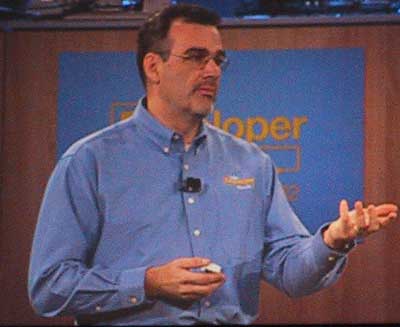
We asked for it and we got it; yesterday we criticized Intel for not featuring the types of demonstrations we're used to seeing at IDF. Today, during Louis Burns' keynote Intel showed off a 4GHz Pentium 4.
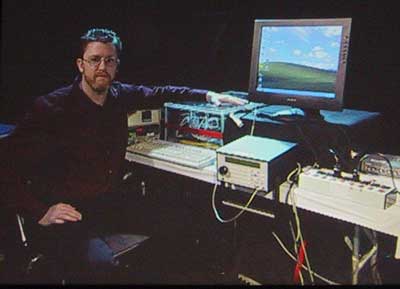
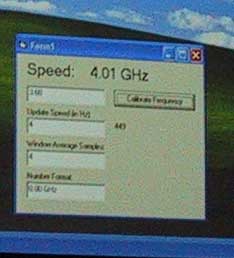 Unfortunately
the demo wasn't as impressive as we had hoped since it was a liquid cooled processor
running nothing more than a frequency display utility. While not as impressive
as yesterday's Hammer demonstration, Intel's forte has always been the ability
to get complex circuits to run at very high speeds and today that's exactly
what we saw today.
Unfortunately
the demo wasn't as impressive as we had hoped since it was a liquid cooled processor
running nothing more than a frequency display utility. While not as impressive
as yesterday's Hammer demonstration, Intel's forte has always been the ability
to get complex circuits to run at very high speeds and today that's exactly
what we saw today.
Today's keynote was a bit more up the AnandTech ally as there was a strong focus on silicon as well as the standards that we all encounter on a day to day basis. There was a lot of talk about the next core to use the NetBurst architecture, 3GIO, and one of the next-generation form factor standards.
Welcoming Prescott
Details on Intel's next-generation NetBurst core have been shady at best. Rumors have been running rampant as usual and generally speaking, most of them are incorrect. Intel did officially introduce the Prescott name and gave us some details about the core:
- 0.09-micron (90nm)
- additional micro-architectural enhancements
- Hyper-Threading on desktops
- shipping in second half 2003
The move down to a 0.09-micron process should allow for even greater clock speeds, including achieving that 4GHz on a Prescott core next year. The additional micro-architectural enhancements are purposefully made vague at this point, however there has been some speculation of a handful of additional instructions for the Prescott core.
Finally the inclusion of Hyper-Threading, enabled, on desktops is a key part of the Prescott launch mainly because it is made under the assumption that by then most applications will be Hyper-Threading aware and will be optimized to dynamically disable or enable and use Hyper-Threading to improve performance. While the second half of 2003 seems like its incredibly far away, realize that on the desktop the vast majority of applications currently aren't written to take advantage of Hyper-Threading (or written to disable it upon startup). This means that we'd need new versions of all Office applications, games, etc... If the software community does begin coding with Hyper-Threading in mind then this could mean quite a bit for the future of NetBurst based processors.
The Future of the PC
With this IDF Intel has started a new commitment to the industry; every IDF, Intel will provide a concept PC that is designed to represent the future of computing. At the show Intel had their new concept platform for release in the second half of 2003.
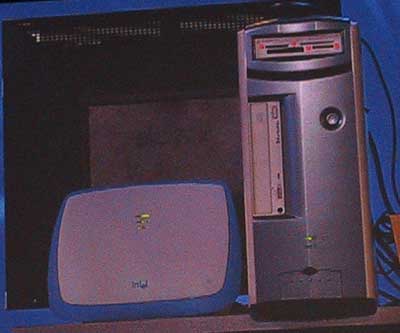
The platform is called Lecta and some of the technology that went into it is actually quite impressive.

Heatpipe core on the left, copper core on the right
Intel showed off a new heatsink designed to improve cooling efficiency. The fins at the base of the heatsink are slightly bent to allow for the maximization of air flow efficiency over the surface area. The core of the heatsink is made of copper and Intel even went one step further to offer a similar design with a greater fin density and heat pipes in the center of the heatsink instead of a solid copper block.
The fan used with this heatsink is designed to bring in air from the sides instead of the top like most conventional fans. Engineers at Intel's Labs have apparently found this to be more effective in cooling with their new heatsink.
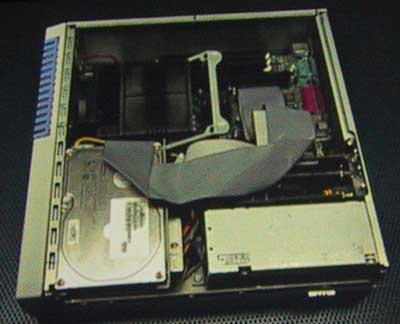
The Lecta platform also did some rearranging of the internals, with the CPU placed near the front of the chassis in order to receive the coolest intake air before anything else. Because of the small form factor, the internals of Lecta look very much like the inside of the Xbox with obvious changes.
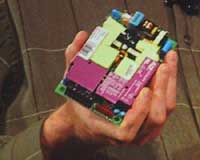
Moving forward, it will become necessary to have very powerful PSUs present in very small spaces. Intel demonstrated another power supply technology which supposedly has 3x the power per cubic inch of current power supplies. There wasn't any more information given about the unit.
 The
final point made about Lecta was that reducing and controlling EMI will become
an issue going forward as the concept design requires some very large vents
at the back of the chassis. Large vents translates into avenues for EMI to escape
thus making FCC certification a nightmare. Intel provided some guidelines for
reducing EMI and even introduced their frequency/EMI generator which is capable
of simulating the EMI generated by processors operating at up to 8GHz in frequency
to make today's designs future-ready.
The
final point made about Lecta was that reducing and controlling EMI will become
an issue going forward as the concept design requires some very large vents
at the back of the chassis. Large vents translates into avenues for EMI to escape
thus making FCC certification a nightmare. Intel provided some guidelines for
reducing EMI and even introduced their frequency/EMI generator which is capable
of simulating the EMI generated by processors operating at up to 8GHz in frequency
to make today's designs future-ready.
New Form Factors
Intel introduced two new form factors today as well. The Tidewater form factor will be a logical evolution of the current microATX form factor and it will be made available in April of this year.
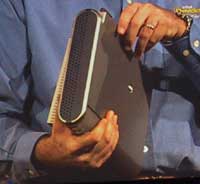
Intel also showed off their Bigwater form factor which is a concept 3GIO platform. The design is very reminiscent of a Playstation 2 and not of a PC and it should be available as a platform in 2004.

Louis inserting/removing a 3GIO module
The most unique feature is that the Bigwater platform won't use expansion cards but it will be upgraded through the use of 3GIO modules.
Another day, another story
That's all for now, back to the show! Be sure to listen to CNet Radio at 11AM PST today (2/27) for my live show coverage.







